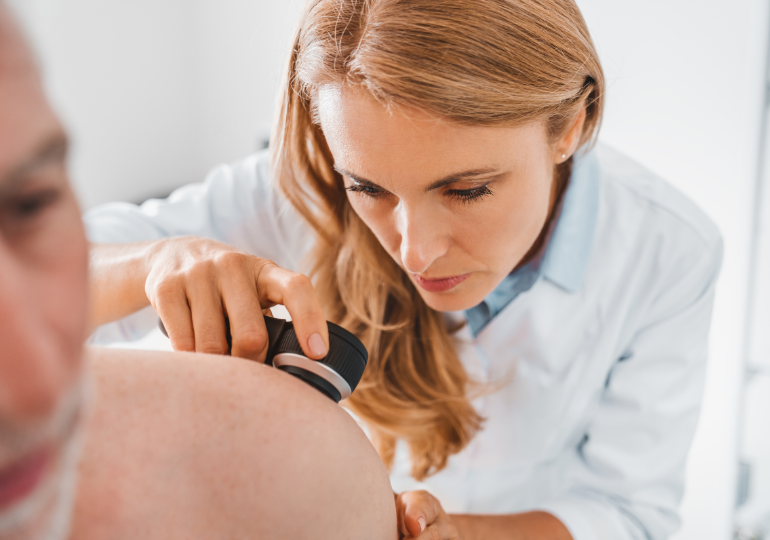Melanoma is a serious form of skin cancer, and early detection is crucial since treatment is more likely to be successful for early-stage melanoma. According to Dr. Arianna Yanes, MD, FAAD of U.S. Dermatology Partners in Annapolis, “The common signs of melanoma are referred to as the A, B, C, D, Es. This stands for Asymmetry, Border irregularity, Color variation, large Diameter, and Evolving over time. However, not all types of melanomas are easily described with these characteristics.” In this blog, Dr. Yanes covers some atypical signs of melanoma, helping you stay vigilant about changes in your skin, and understand when you should report changes to your dermatologist.
What Are the Uncommon Signs of Melanoma?
Many melanomas are asymmetrical, darkly pigmented, have irregular shapes or borders or are large in diameter. According to Dr. Yanes, “Not all melanomas follow these patterns, and they are more difficult to detect. Uncommon types of melanoma can mimic benign skin concerns, so knowing what to look for can empower you to bring new and changing lesions to your dermatologist.”
Other Melanoma Signs to Watch For
What other melanoma signs should you be checking for during monthly skin exams? Dr. Yanes recommends patients take note of the following potential signs of melanoma that are easy to miss during their skin cancer self-checks:
- New spots that don’t heal – one of the most important signs of skin cancer is a new lesion on skin that doesn’t resolve within a few weeks. Even if a spot doesn’t show significant changes in appearance, it is worth noting lesions that do not heal or disappear on their own.
- Amelanotic (pink) melanoma – melanoma takes its name from pigment-producing melanocyte cells in skin, and most melanomas will have brown pigment. Rarely, melanomas can be pink or skin colored and may look similar to moles or benign skin growths. Paying attention to new lesions can help identify these difficult-to-diagnose melanomas.
- The “ugly duckling” sign – this concept involves examining the skin for any spot that looks different from others. Even if a lesion doesn’t meet the standard A, B, C, D, E criteria, it might still be unusual, standing out like an “ugly duckling” among other spots. A mole or spot that looks different from others in terms of color, shape, or size should be examined closely. This sign can be particularly useful for people with many moles.
- Dark lesions on soles of feet or palms of hands – acral lentiginous melanoma, a type of melanoma more common in people with skin of color, often develops on the soles of feet or palms of hands. Regularly checking your feet and hands can help identify changes, even if they don’t follow the usual A, B, C, D, E characteristics.
- Streaks on fingernails or toenails – subungual melanoma is a type of skin cancer that appears as irregular and thick dark brown or black vertical lines beneath the fingernails or toenails. A band of darker skin may also form around the base of the nail.
- Lesions on eyelids, lips, or genitals – irregular forms of melanoma can also occur on the eyelids, lips, and genitals and can present as brown spots. These areas may be overlooked during routine skin self-checks.
Perform Regular Skin Exams to Monitor for Melanoma
According to Dr. Yanes, “Performing regular skin cancer self-checks helps you become familiar with skin’s baseline appearance. By monitoring changes, you will be able to quickly identify any unusual developments, including the uncommon signs of melanoma. When conducting self-checks, make sure to evaluate often overlooked areas like your back, scalp, and the soles of your feet. Ask for assistance, use mirrors, and always utilize bright lighting to ensure you see skin clearly during your self-exam.”
When to See a Dermatologist
If you’ve identified something unusual during a self-exam, Dr. Yanes recommends evaluation by a dermatologist. “Your dermatologist will assess suspicious growths and may perform skin biopsies to evaluate for melanoma and other forms of skin cancer. During the exam, it’s helpful to bring up any new or changing lesions that you have noticed.”
Schedule a Consultation with a Dermatologist
Regular skin cancer screenings with a dermatologist, especially if you notice any unusual signs, can help with early detection of melanoma and other skin cancers. Dermatologists provide guidance and expertise needed to stay proactive about skin health. If you’ve observed any concerning changes in your skin, don’t hesitate to consult one of the trusted dermatologists at U.S. Dermatology Partners. Getting started is quick and easy. Just take a moment to fill out our online scheduling form, and a local dermatology office will be in touch soon.
Find a location near me
or


